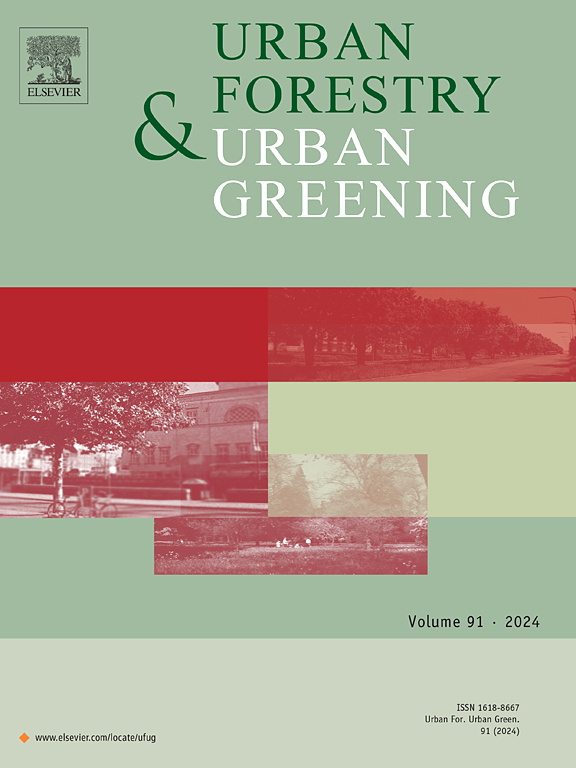从天空到地面:通过深度学习的多源遥感图像监测可见的街道绿化
IF 6.7
2区 环境科学与生态学
Q1 ENVIRONMENTAL STUDIES
引用次数: 0
摘要
绿色景观指数(GVI)是评价城市环境的重要指标,对提高居民福祉和促进城市生态健康具有重要意义。使用街景图像(SVIs)提取GVI是一种常见的做法。然而,由于城市街道绿化通常会随着时间的推移而持续变化,因此仅使用时空稀疏的svi将无法全面捕捉GVI的动态,从而可能在相关研究和决策中引入偏差。为了填补这一空白,本研究提出了一个使用多源卫星图像和深度学习技术估计GVI的新框架。我们首先从道路网沿线收集的SVI数据中获得GVI信息,并采用时空匹配方法建立GVI与遥感(RS)图像的配对样本。随后,我们开发了一个具有通道注意机制的多任务深度学习模型,用于改进GVI估计。此外,我们利用GVI的物理特性,将多个基于知识的特征与原始RS波段作为输入,以提高模型的学习效率和整体性能。在中国上海和南京的实验结果表明,GVI估计值与实际值的R2值在点水平上可以达到0.716,在街道水平上可以达到0.834。本研究验证了利用卫星图像监测GVI的可行性,为评价城市绿化和推进环境健康研究提供了坚实的技术和数据基础。本文章由计算机程序翻译,如有差异,请以英文原文为准。
From sky to ground: Monitoring visible street greenery via multisource remote sensing imagery with deep learning
The Green View Index (GVI) is a critical metric for assessing urban environments and has significant implications for enhancing residents’ well-being and promoting urban ecological health. Extracting GVI using street view images (SVIs) is a common practice. However, since urban street greenery generally undergoes a continuous change over time, solely using SVIs that are spatiotemporally sparse would fail to comprehensively capture the dynamics of GVI, potentially introducing biases into related research and policy-making. To fill that gap, this study proposes a new framework to estimate GVI using multi-source satellite imagery and deep learning technique. We first derive GVI information from SVI data collected along road networks and employ a spatiotemporal matching approach to establish paired samples linking GVI with remote sensing (RS) imagery. Subsequently, we develop a multi-task deep learning model with channel attention mechanisms for refined GVI estimation. Furthermore, leveraging the physical properties of GVI, we integrate multiple knowledge-based features with the raw RS bands as inputs to enhance the learning efficiency and overall performance of the model. Experimental results in Shanghai and Nanjing, China, show that the value of the GVI estimates against actual values can reach 0.716 at the point level and 0.834 at the street level. This study validates the feasibility of using satellite imagery to monitor GVI, offering robust technical and data foundations for evaluating urban greening and advancing environmental health studies.
求助全文
通过发布文献求助,成功后即可免费获取论文全文。
去求助
来源期刊

Urban Forestry & Urban Greening
FORESTRY-
CiteScore
11.70
自引率
12.50%
发文量
289
审稿时长
70 days
期刊介绍:
Urban Forestry and Urban Greening is a refereed, international journal aimed at presenting high-quality research with urban and peri-urban woody and non-woody vegetation and its use, planning, design, establishment and management as its main topics. Urban Forestry and Urban Greening concentrates on all tree-dominated (as joint together in the urban forest) as well as other green resources in and around urban areas, such as woodlands, public and private urban parks and gardens, urban nature areas, street tree and square plantations, botanical gardens and cemeteries.
The journal welcomes basic and applied research papers, as well as review papers and short communications. Contributions should focus on one or more of the following aspects:
-Form and functions of urban forests and other vegetation, including aspects of urban ecology.
-Policy-making, planning and design related to urban forests and other vegetation.
-Selection and establishment of tree resources and other vegetation for urban environments.
-Management of urban forests and other vegetation.
Original contributions of a high academic standard are invited from a wide range of disciplines and fields, including forestry, biology, horticulture, arboriculture, landscape ecology, pathology, soil science, hydrology, landscape architecture, landscape planning, urban planning and design, economics, sociology, environmental psychology, public health, and education.
 求助内容:
求助内容: 应助结果提醒方式:
应助结果提醒方式:


